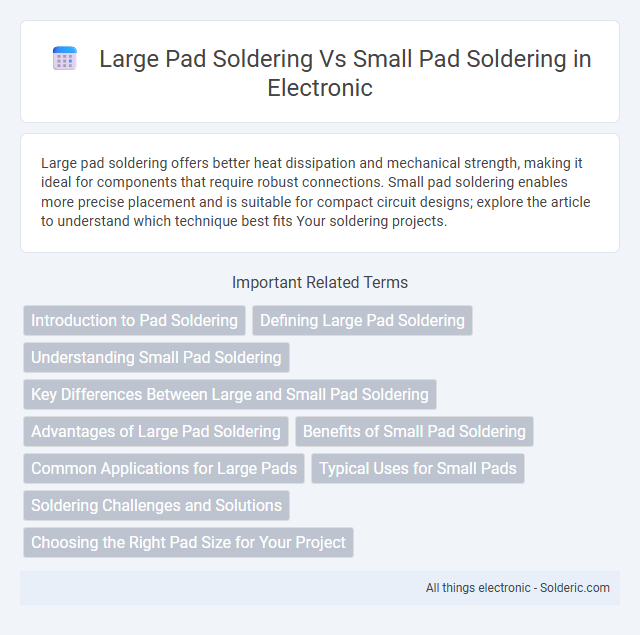Large pad soldering offers better heat dissipation and mechanical strength, making it ideal for components that require robust connections. Small pad soldering enables more precise placement and is suitable for compact circuit designs; explore the article to understand which technique best fits Your soldering projects.
Comparison Table
| Aspect | Large Pad Soldering | Small Pad Soldering |
|---|---|---|
| Solder Joint Strength | Higher due to larger surface area | Lower; less surface contact |
| Heat Dissipation | Better heat sinking capability | Poorer heat dissipation, risk of thermal damage |
| Assembly Precision | More tolerant to placement errors | Requires high precision placement |
| Solder Volume | Higher amount of solder needed | Minimal solder volume |
| Inspection Ease | Easier visual inspection | Challenging to inspect microscopically |
| Rework Complexity | Simpler to rework | Complex and riskier rework |
| Application | Power electronics, high-current connections | Fine-pitch ICs, small passive components |
Introduction to Pad Soldering
Large pad soldering provides greater heat dissipation, ensuring strong mechanical and electrical connections for components exposed to higher thermal loads. Small pad soldering requires precision and careful thermal management to avoid damaging sensitive components and ensure reliable connections on compact PCB layouts. Your soldering technique should adapt to pad size, balancing heat application and solder volume for optimal joint integrity.
Defining Large Pad Soldering
Large pad soldering involves attaching components to printed circuit board (PCB) pads that have a significantly larger surface area compared to small pads, enhancing heat dissipation and mechanical stability. This technique is essential for components that generate substantial heat or require strong mechanical support, such as power semiconductors and connectors. Proper pad sizing and thermal design in large pad soldering improve solder joint reliability and reduce thermal stress during the reflow process.
Understanding Small Pad Soldering
Small pad soldering requires precise temperature control and solder volume to prevent pad lifting and ensure reliable electrical connections. Compared to large pad soldering, small pads demand advanced soldering techniques like micro soldering and fine-pitch component handling to avoid damage and maintain circuit integrity. Mastery of small pad soldering is essential for high-density PCB assemblies and miniaturized electronic devices.
Key Differences Between Large and Small Pad Soldering
Large pad soldering involves higher thermal mass, requiring increased heat input and longer dwell time to ensure proper solder joint formation, whereas small pad soldering demands precise temperature control to avoid pad lifting or damage. The solder fillet size and wetting characteristics differ significantly, with large pads promoting better mechanical strength due to increased contact area, while small pads necessitate meticulous alignment for effective connectivity. Thermal dissipation rates vary, impacting solder joint reliability and necessitating tailored reflow profiles for each pad size to optimize solderability and minimize defects.
Advantages of Large Pad Soldering
Large pad soldering offers enhanced mechanical strength and thermal dissipation compared to small pad soldering, reducing the risk of joint failure under stress. The increased surface area improves heat conductivity, facilitating better solder flow and stronger electrical connections. This method is particularly beneficial for components with high current requirements or those exposed to mechanical vibrations.
Benefits of Small Pad Soldering
Small pad soldering offers precise control over solder volume, reducing the risk of bridging and improving joint reliability. It enables more compact PCB designs and enhances thermal management by minimizing heat dissipation variances. You benefit from higher assembly density and better electrical performance in complex electronic circuits.
Common Applications for Large Pads
Large pad soldering is commonly used in high-power electronic components such as power transistors, connectors, and heat sink mounts, where enhanced thermal dissipation and mechanical stability are crucial. These large pads facilitate better heat transfer and support higher current loads, making them ideal for automotive electronics, power supplies, and industrial control systems. The increased pad size also aids in reliable solder joint formation during reflow soldering in surface-mount technology (SMT) applications.
Typical Uses for Small Pads
Small pad soldering is typically used for fine-pitch components such as ICs, resistors, and capacitors on densely populated PCBs where space is limited. These pads enable precise soldering and reliable electrical connections, supporting high-density board designs common in smartphones, laptops, and advanced electronics. Your circuit's performance depends on the accurate placement and soldering of these small pads to ensure signal integrity and durability.
Soldering Challenges and Solutions
Large pad soldering often presents challenges such as excessive heat dissipation and difficulty in achieving uniform solder joints, which can lead to cold solder joints or bridging. Small pad soldering, meanwhile, faces issues like insufficient wetting area and higher risk of pad lifting due to concentrated heat and mechanical stress. Solutions for large pads include controlled preheating and optimized reflow profiles to ensure even heat distribution, while small pads benefit from precision solder paste application and the use of fluxes that enhance wetting and adhesion.
Choosing the Right Pad Size for Your Project
Choosing the right pad size for your project depends on the component type and thermal management requirements. Large pads provide better heat dissipation and mechanical strength, making them ideal for power components and high-current applications. Small pads are suitable for fine-pitch ICs and delicate components where precision and space-saving are critical, but they require careful soldering to avoid insufficient solder joint reliability.
large pad soldering vs small pad soldering Infographic

 solderic.com
solderic.com